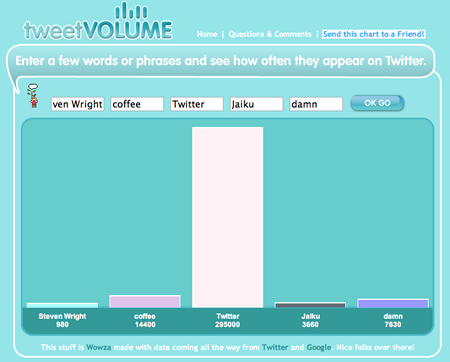Twitter, the status stream tool some refer to as a mini-blog, saw two new integration apps released recently to widen the community. A new Twitter Facebook application—which brings Tweets into the profiles of members of that community—was joined by TweetVolume, a monitor of the public stream of 140-character messages from Twitterers.
TweetVolume is a new site monitoring the public stream of Tweets and showing frequency of words, pulling data from both Twitter and Google. According to a comment by Will Garrison, a Wowza developer who helped create the site:
The results are each an estimated (not by me!) count of the number of times a word or phrase has appeared in a Twitter post. I do this by simply asking Google. I actually have a version of the site that returns the most relevant posts from Twitter but because of Twitter’s down time of late that feature is pretty darn slow(!) and won’t be rolled out until they are once again running smoothly.
The colors used for the simple bar chart change with each load, as do the numbers sometimes (the first time I ran the query above, “coffee” was flatlined … yeah, right). You can create permalinks for a given set of search terms by including a query string, like “search_phrases=Steven+Wright,coffee,Twitter,Jaiku,damn” as part of the URL.
In traditional Web 2.0 fashion, this app is released before it has matured. The bar chart isn’t a great visualization, only functional in one dimension (this is more than that). My expectation is that the foundation has now been laid for more interesting visualizations, like tag clouds, word networks, user replies, and—here’s hoping!—a tweet browser. The time frame right now is Everything Google Sees Since Twitter Has Been Around … not a very useful time frame for discovery. Imagine how great TweetVolume could easily be for research if there were someway to configure time spans or incorporate filters, especially when the inevitable spweets start surfacing. I wonder how “viagra” and “hot porn” would do head-to-head.
I have great interest in the applications of Twitter for general Internet research and as a specific pseudo-ethnographic tool of design. However, how are discovery tools like this going to change the simplicity of Twitter that makes it so appealing? I’ve kept my circle of Twitter friends small and purposefully known, so I care about the little messages that pop up throughout the day. The apt metaphor someone once used was that Twitter was the online equivalent of bumping into a friend in the hallway or on the street and saying, “What’s up?” I don’t want those low-effort but important conversations distorted by some other dynamic or user motivation.
Still, the biggest gripe I have about TweetVolume is that too few are talking about me. But you can’t shoot the messenger.
